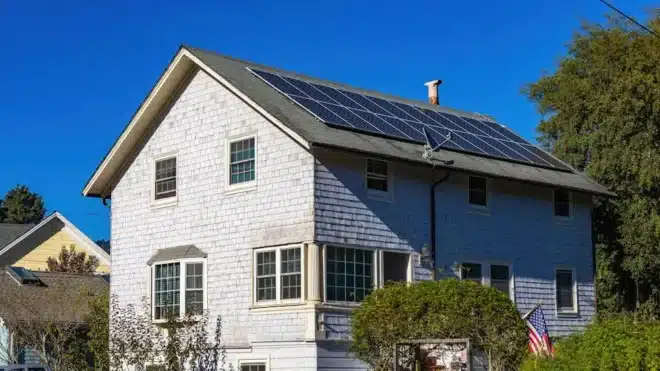Vermont’s stunning landscapes are a sight to behold, but the state’s unique climate brings distinct challenges for homeowners looking to maintain their sustainable roofing systems. This guide provides you with practical and easy-to-follow tips that will help you protect your roof throughout the seasonal changes, ensuring it remains efficient and durable for years to come.
1. Prepare for Winter’s Chill
As the cold weather approaches, it’s crucial to inspect your roof for any vulnerabilities. Ensure that all shingles are intact and secure, as strong winter storms can carry heavy snow and ice.
Don’t forget to check the integrity of your flashing too. Flashing protects joints and areas where water may infiltrate, so ensuring it’s properly installed and not damaged can save you from costly leaks down the road.
Additionally, think about adding insulation to your attic space. A well-insulated attic prevents heat loss, which can lead to ice dams forming on your roof. This simple adjustment can make a significant difference in both winter comfort and roofing health.
2. Spring Cleaning for Your Roof
Once winter has passed, conduct a thorough cleaning to remove any debris. This prevents mold growth and allows your roof to perform optimally as temperatures rise.
Be sure to focus on areas where leaves tend to accumulate, as they can trap moisture and encourage rot. Using a leaf blower or a gentle brush can effectively remove these obstacles without damaging your roofing material.
Consider scheduling a professional cleaning once a year. Experts can provide a deeper clean and inspect your roof for damage that might have occurred during winter storms. Handling this promptly can save time and money in the longer run.
3. Check for Ice Dams
During winter, keep an eye out for ice dams which can form along the eaves. These can lead to water leaks inside your home, so ensure your roof has proper ventilation to mitigate the risk.
Improved ventilation can help keep your roof temperature consistent and melt snow more evenly, reducing the chances of ice dam formation. Installing ridge vents or soffit vents may be necessary to create that vital airflow.
If ice dams do form, avoid the temptation to chip away at them with a hammer, which could damage your roof. Instead, consider using a roof rake to remove snow from the roof or consult professionals for safe removal methods.
4. Regular Inspections Year-Round
Schedule regular roof inspections in every season. This will help you catch potential issues early before they escalate into costly repairs.
In the fall, keep an eye out for any shifting or missing shingles, as heavy winds can dislodge them. Spring is an excellent time to find leaks that might be hidden under layers of debris after winter.
Utilizing checklists can make inspections easier. Documenting what you find can assist in tracking the health of your roof over time, making it easier to make necessary repairs or upgrades.
5. Sustainable Materials Make a Difference
Invest in eco-friendly roofing materials that not only protect your home but also benefit the environment. Look for options like reclaimed wood or metal, which can withstand Vermont’s harsh conditions.
Additionally, materials like rubber roofing, often made from recycled tires, are incredibly durable and provide excellent insulation. Choosing sustainable materials not only enhances roof longevity, but also contributes to a smaller carbon footprint.
When discussing material choices with contractors, don’t hesitate to ask about the environmental impact of each option. Educated decisions can lead to long-term benefits for your home and the planet.
6. Clean Gutters After Every Storm
Keeping your gutters clear is crucial for proper drainage. After any storm, make it a habit to remove leaves and debris to prevent clogs and water damage.
Gutters that are clogged can lead to water pooling on your roof, increasing the chances of leaks and structural damage. Regular maintenance is key; using a ladder safely or hiring professionals can alleviate much of the risk associated with this job.
Beyond simply cleaning, consider installing gutter guards. They can help reduce debris accumulation and make your maintenance routine significantly easier. The initial investment can save you considerable hassles in the future.
7. Watch for Sun Damage in Summer
Vermont summers can be surprisingly intense. Check for sun damage on shingles and consider applying reflective coatings to help preserve roofing materials from UV rays.
A reflective coating can significantly reduce heat absorption, keeping your home cooler and further extending the longevity of your roofing materials. It’s a smart investment that pays off in comfort and reduced cooling costs.
Additionally, think about scheduling an inspection in mid-summer. It’s an excellent time to catch any summer storms’ impacts and address them immediately while the weather is still favorable.
8. Address Tree Overhangs
Trees can be both beautiful and problematic. Trim overhanging branches to reduce the risk of branches damaging your roof or causing debris buildup.
Tree limbs can scratch shingles and create spots where water can pool. By proactively trimming them back, you help maintain your roof’s integrity and protect your investment.
Additionally, planting trees further from your home adds shade without risking extensive damage during storms. Consult a landscaper to determine the best trees for your property that won’t grow too close to your roof.
9. Keep an Eye on Flashing
Flashing helps protect vulnerable areas around chimneys and vents. Regularly check for any signs of wear or damage and replace as needed to prevent leaks.
Proper installation of flashing is critical. If you discover damage or missing sections during your inspection, it may be best to engage a professional to ensure that replacements are installed correctly.
Additionally, synthetic flashing is a great durable option. It provides more protection than traditional materials, making it a worthwhile consideration during roof renovations or updates.
10. Prepare for Storm Season
Stay informed about weather forecasts, especially during storm season. Make sure your roofing is secure and ready to withstand strong winds and heavy rain.
Having your emergency kit stocked with essentials, including plastic sheeting and a flashlight, can prove invaluable if storm damage occurs. Minimize debris around your property by securing items that might become projectiles during high winds.
Additionally, ensure that your homeowners’ insurance policy adequately covers storm-related damage. Understanding your coverage will alleviate some stress if anything unfortunate happens during storm season.
11. Consider a Roof-Coating Option
Applying a roof coating can provide additional protection against the elements and improve energy efficiency. Explore eco-friendly options that align with your sustainability goals.
A quality roof coating serves as a safeguard against UV rays and harsh weather while enhancing the aesthetic appeal of your home. Make sure to consult professionals to ensure proper application for maximum benefits.
Also, regularly re-evaluating the effectiveness of your roof coating will help you make timely decisions about reapplication, ensuring continuous protection against environmental factors.
12. Engage Professionals for Maintenance
While DIY maintenance is great, there are times when professional help is necessary. Don’t hesitate to call in experts for a thorough assessment and maintenance task.
Seasonal inspection by professionals often uncovers issues that go unnoticed during routine checks. They have specialized tools and insights that can save you from significant expenses down the line.
Fostering a relationship with a trusted roofing contractor ensures you have a knowledgeable partner ready to assist when challenges arise. Its mutual benefit in preserving your sustainable roofing system for years to come.



